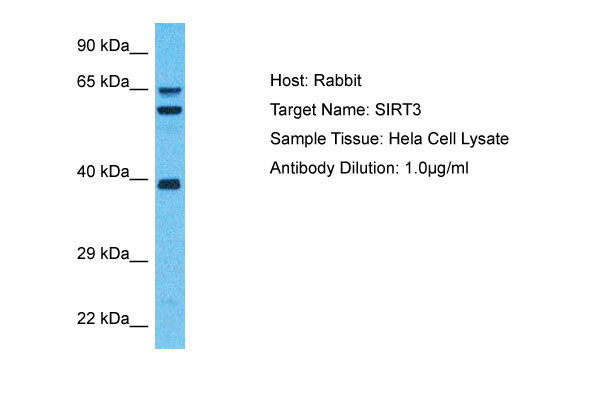SIR3 Antibody - N-terminal region
Rabbit Polyclonal Antibody
- SPECIFICATION
- CITATIONS
- PROTOCOLS
- BACKGROUND

Application
| WB |
|---|---|
| Primary Accession | Q9NTG7 |
| Other Accession | NP_036371 |
| Reactivity | Human |
| Host | Rabbit |
| Clonality | Polyclonal |
| Calculated MW | 43kDa |
| Gene ID | 23410 |
|---|---|
| Alias Symbol | SIRT3, SIR2L3, |
| Other Names | NAD-dependent protein deacetylase sirtuin-3, mitochondrial, hSIRT3, 3.5.1.-, Regulatory protein SIR2 homolog 3, SIR2-like protein 3, SIRT3, SIR2L3 |
| Format | Liquid. Purified antibody supplied in 1x PBS buffer with 0.09% (w/v) sodium azide and 2% sucrose. |
| Reconstitution & Storage | Add 50 &mu, l of distilled water. Final Anti-SIR3 antibody concentration is 1 mg/ml in PBS buffer with 2% sucrose. For longer periods of storage, store at -20°C. Avoid repeat freeze-thaw cycles. |
| Precautions | SIR3 Antibody - N-terminal region is for research use only and not for use in diagnostic or therapeutic procedures. |
| Name | SIRT3 |
|---|---|
| Synonyms | SIR2L3 |
| Function | NAD-dependent protein deacetylase (PubMed:12186850, PubMed:12374852, PubMed:16788062, PubMed:18680753, PubMed:18794531, PubMed:23283301, PubMed:24121500, PubMed:24252090, PubMed:19535340). Activates or deactivates mitochondrial target proteins by deacetylating key lysine residues (PubMed:12186850, PubMed:12374852, PubMed:16788062, PubMed:18680753, PubMed:18794531, PubMed:23283301, PubMed:24121500, PubMed:24252090). Known targets include ACSS1, IDH, GDH, SOD2, PDHA1, LCAD, SDHA and the ATP synthase subunit ATP5PO (PubMed:16788062, PubMed:18680753, PubMed:24121500, PubMed:24252090, PubMed:19535340). Contributes to the regulation of the cellular energy metabolism (PubMed:24252090). Important for regulating tissue-specific ATP levels (PubMed:18794531). In response to metabolic stress, deacetylates transcription factor FOXO3 and recruits FOXO3 and mitochondrial RNA polymerase POLRMT to mtDNA to promote mtDNA transcription (PubMed:23283301). Acts as a regulator of ceramide metabolism by mediating deacetylation of ceramide synthases CERS1, CERS2 and CERS6, thereby increasing their activity and promoting mitochondrial ceramide accumulation (By similarity). Regulates hepatic lipogenesis. Uses NAD(+) substrate imported by SLC25A47, triggering downstream activation of PRKAA1/AMPK-alpha signaling cascade that ultimately downregulates sterol regulatory element-binding protein (SREBP) transcriptional activities and ATP-consuming lipogenesis to restore cellular energy balance. |
| Cellular Location | Mitochondrion matrix |
| Tissue Location | Widely expressed. |

Thousands of laboratories across the world have published research that depended on the performance of antibodies from Abcepta to advance their research. Check out links to articles that cite our products in major peer-reviewed journals, organized by research category.
info@abcepta.com, and receive a free "I Love Antibodies" mug.
Provided below are standard protocols that you may find useful for product applications.
Background
NAD-dependent protein deacetylase. Activates or deactivates mitochondrial target proteins by deacetylating key lysine residues. Known targets include ACSS1, IDH, GDH, SOD2, PDHA1, LCAD, SDHA and the ATP synthase subunit ATP5O. Contributes to the regulation of the cellular energy metabolism. Important for regulating tissue-specific ATP levels.
References
Frye R.A.,et al.Biochem. Biophys. Res. Commun. 260:273-279(1999).
Ota T.,et al.Nat. Genet. 36:40-45(2004).
Taylor T.D.,et al.Nature 440:497-500(2006).
Bechtel S.,et al.BMC Genomics 8:399-399(2007).
Schwer B.,et al.J. Cell Biol. 158:647-657(2002).
If you have used an Abcepta product and would like to share how it has performed, please click on the "Submit Review" button and provide the requested information. Our staff will examine and post your review and contact you if needed.
If you have any additional inquiries please email technical services at tech@abcepta.com.













 Foundational characteristics of cancer include proliferation, angiogenesis, migration, evasion of apoptosis, and cellular immortality. Find key markers for these cellular processes and antibodies to detect them.
Foundational characteristics of cancer include proliferation, angiogenesis, migration, evasion of apoptosis, and cellular immortality. Find key markers for these cellular processes and antibodies to detect them. The SUMOplot™ Analysis Program predicts and scores sumoylation sites in your protein. SUMOylation is a post-translational modification involved in various cellular processes, such as nuclear-cytosolic transport, transcriptional regulation, apoptosis, protein stability, response to stress, and progression through the cell cycle.
The SUMOplot™ Analysis Program predicts and scores sumoylation sites in your protein. SUMOylation is a post-translational modification involved in various cellular processes, such as nuclear-cytosolic transport, transcriptional regulation, apoptosis, protein stability, response to stress, and progression through the cell cycle. The Autophagy Receptor Motif Plotter predicts and scores autophagy receptor binding sites in your protein. Identifying proteins connected to this pathway is critical to understanding the role of autophagy in physiological as well as pathological processes such as development, differentiation, neurodegenerative diseases, stress, infection, and cancer.
The Autophagy Receptor Motif Plotter predicts and scores autophagy receptor binding sites in your protein. Identifying proteins connected to this pathway is critical to understanding the role of autophagy in physiological as well as pathological processes such as development, differentiation, neurodegenerative diseases, stress, infection, and cancer.


